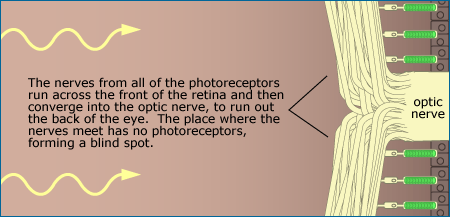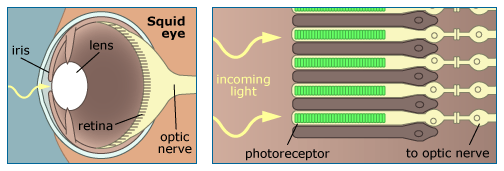 In the literal blink of an eye, you can perceive and respond to visual triggers — like a word on a computer screen, a low-hanging tree branch, or even an oncoming car. But how does this lightning-fast process actually work?
In the literal blink of an eye, you can perceive and respond to visual triggers — like a word on a computer screen, a low-hanging tree branch, or even an oncoming car. But how does this lightning-fast process actually work?
Your eye works like this. The colored part of your eye, the iris, prevents light from entering your eye from too many different directions at once by controlling the size of your pupil — the dark spot in the middle of your eye, through which light enters. This light then passes through the lens, which helps focus it onto the retina at the back of your eye. The retina contains photoreceptor cells. Special pigments within those cells absorb the light’s energy and transform it into an electrical signal that is sent to the brain via nerves. Finally, the brain puts these different signals from different photoreceptors together into an image.
The vertebrate eye is a complex adaptation that has evolved over many millions of year — and like other complex adaptations, it still bears the marks of that evolutionary history. The fish-like ancestor of all vertebrates had photoreceptor cells that were oriented away from incoming light — that is, the light-absorbing pigments were located at the “back” of the cell (away from the light) and the signal-producing part of the cell was located at the “front” (towards the light).

We have inherited the same kind of backwards photoreceptor cell from that ancestor — but it causes a bit of a problem for us. This orientation means that the nerves that carry visual signals to our brains must run across the front of the retina. Since the nerves are transparent, they themselves don’t interfere with our vision much — but in order to exit the eye and reach the brain, those nerves all converge at a spot on the back of the eye called the optic disc, where they leave the eye. That exit point is crammed full of nerves, so there is no room for photoreceptors. Without photoreceptors in that area, the optic disc cannot sense light that strikes it, forming a blind spot at this position.

Interestingly, through convergent evolution, squid and octopus have evolved an eye layout that is remarkably similar to our own. They also have large eyes, with a lens, iris, and single large interior chamber, as shown below, which provide them with excellent vision. However, they inherited photoreceptor cells that are oriented towards the light, so that their visual nerves run behind the retina — and hence, squid and octopus have no blind spot.

